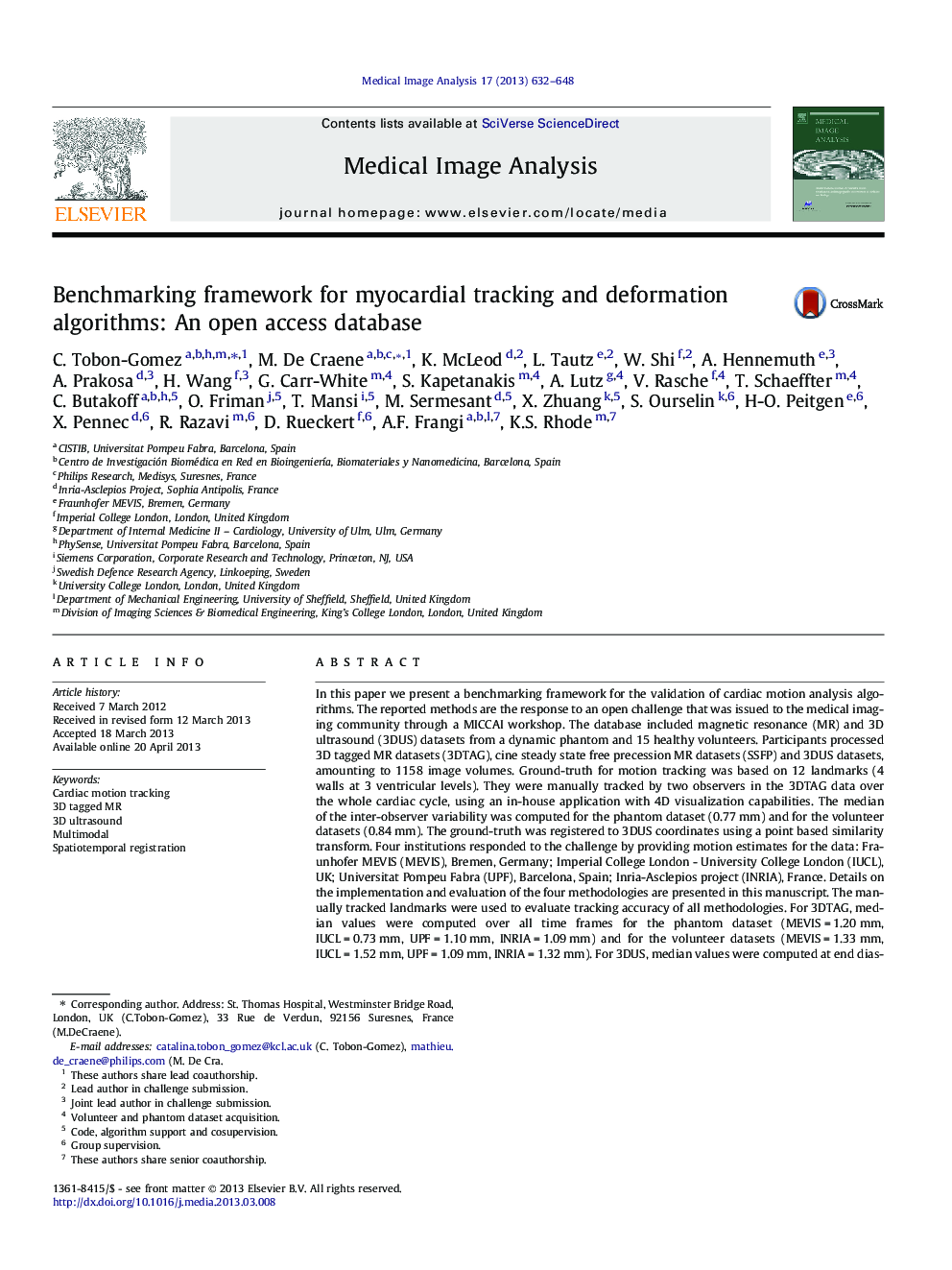| کد مقاله | کد نشریه | سال انتشار | مقاله انگلیسی | نسخه تمام متن |
|---|---|---|---|---|
| 10337642 | 692876 | 2013 | 17 صفحه PDF | دانلود رایگان |
عنوان انگلیسی مقاله ISI
Benchmarking framework for myocardial tracking and deformation algorithms: An open access database
ترجمه فارسی عنوان
چارچوب ارزیابی برای الگوریتم های ردیابی و تغییر شکل قلب: پایگاه داده دسترسی آزاد
دانلود مقاله + سفارش ترجمه
دانلود مقاله ISI انگلیسی
رایگان برای ایرانیان
موضوعات مرتبط
مهندسی و علوم پایه
مهندسی کامپیوتر
گرافیک کامپیوتری و طراحی به کمک کامپیوتر
چکیده انگلیسی
In this paper we present a benchmarking framework for the validation of cardiac motion analysis algorithms. The reported methods are the response to an open challenge that was issued to the medical imaging community through a MICCAI workshop. The database included magnetic resonance (MR) and 3D ultrasound (3DUS) datasets from a dynamic phantom and 15 healthy volunteers. Participants processed 3D tagged MR datasets (3DTAG), cine steady state free precession MR datasets (SSFP) and 3DUS datasets, amounting to 1158 image volumes. Ground-truth for motion tracking was based on 12 landmarks (4 walls at 3 ventricular levels). They were manually tracked by two observers in the 3DTAG data over the whole cardiac cycle, using an in-house application with 4D visualization capabilities. The median of the inter-observer variability was computed for the phantom dataset (0.77Â mm) and for the volunteer datasets (0.84Â mm). The ground-truth was registered to 3DUS coordinates using a point based similarity transform. Four institutions responded to the challenge by providing motion estimates for the data: Fraunhofer MEVIS (MEVIS), Bremen, Germany; Imperial College London - University College London (IUCL), UK; Universitat Pompeu Fabra (UPF), Barcelona, Spain; Inria-Asclepios project (INRIA), France. Details on the implementation and evaluation of the four methodologies are presented in this manuscript. The manually tracked landmarks were used to evaluate tracking accuracy of all methodologies. For 3DTAG, median values were computed over all time frames for the phantom dataset (MEVISÂ =Â 1.20Â mm, IUCLÂ =Â 0.73Â mm, UPFÂ =Â 1.10Â mm, INRIAÂ =Â 1.09Â mm) and for the volunteer datasets (MEVISÂ =Â 1.33Â mm, IUCLÂ =Â 1.52Â mm, UPFÂ =Â 1.09Â mm, INRIAÂ =Â 1.32Â mm). For 3DUS, median values were computed at end diastole and end systole for the phantom dataset (MEVISÂ =Â 4.40Â mm, UPFÂ =Â 3.48Â mm, INRIAÂ =Â 4.78Â mm) and for the volunteer datasets (MEVISÂ =Â 3.51Â mm, UPFÂ =Â 3.71Â mm, INRIAÂ =Â 4.07Â mm). For SSFP, median values were computed at end diastole and end systole for the phantom dataset(UPFÂ =Â 6.18Â mm, INRIAÂ =Â 3.93Â mm) and for the volunteer datasets (UPFÂ =Â 3.09Â mm, INRIAÂ =Â 4.78Â mm). Finally, strain curves were generated and qualitatively compared. Good agreement was found between the different modalities and methodologies, except for radial strain that showed a high variability in cases of lower image quality.
ناشر
Database: Elsevier - ScienceDirect (ساینس دایرکت)
Journal: Medical Image Analysis - Volume 17, Issue 6, August 2013, Pages 632-648
Journal: Medical Image Analysis - Volume 17, Issue 6, August 2013, Pages 632-648
نویسندگان
C. Tobon-Gomez, M. De Craene, K. McLeod, L. Tautz, W. Shi, A. Hennemuth, A. Prakosa, H. Wang, G. Carr-White, S. Kapetanakis, A. Lutz, V. Rasche, T. Schaeffter, C. Butakoff, O. Friman, T. Mansi, M. Sermesant, X. Zhuang, K.S. Rhode,
